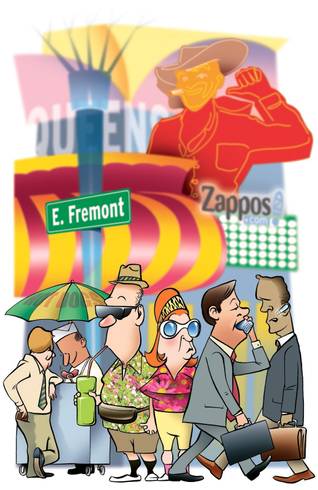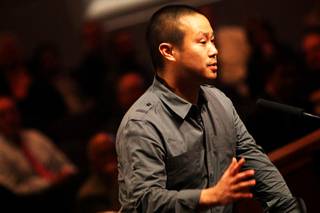Wednesday, Jan. 5, 2011 | 2 a.m.
Sun archives
- Mayor: Zappos move will make it easier to market downtown Las Vegas (12-2-2010)
- Goodman: Zappos move a ‘watershed moment’ for downtown Las Vegas (12-1-2010)
- City of Henderson taking departure of Zappos.com in stride (12-1-2010)
- Zappos views Las Vegas City Hall as perfect fit for new headquarters (11-29-2010)
- Henderson’s Zappos.com listed among best places to work (1-22-2010)
- From upstart to $1 billion behemoth, Zappos marks 10 years (6-16-2009)
- Henderson-based Zappos earns honors for ethics (4-13-2009)
For 40 years, downtown Las Vegas has been “Old Vegas,” and justifiably so. Binion's, the El Cortez, even the newly gilded Golden Nugget are museum pieces next to most Strip hotels.
As a result, downtown has suffered economically. In the future, however, casino glitz might not count for much in and around Fremont Street.
A month after online shoe and clothing retailer Zappos.com announced it would move downtown and make Las Vegas City Hall its headquarters, there are signs the area’s economic resurgence might rely more on technology and less on gaming.
Zappos CEO Tony Hsieh, who since the announcement has become a leader of sorts for the downtown boosters, told the Sun he is talking to other San Francisco Bay Area firms about moving to a high-tech business incubator that could be developed on acreage that Zappos will lease downtown.
“It’s all about creating an environment that appeals to the creative class and creating more serendipitous interactions among employees and the community,” Hsieh said in an e-mail.
Hsieh believes creating that atmosphere requires gathering places frequented by locals, not tourists seeking slot machines. And he sees the beginnings of it on nearby East Fremont — also on the east side of Las Vegas Boulevard — the entertainment district where gaming is prohibited. A majority of the customers at East Fremont’s Vanguard, Griffin, Downtown Cocktail Room and the Beat coffee shop are Las Vegans.
“It’s important that the bars are nongaming,” Hsieh said. “We’re not looking to draw more tourists, we’re looking to build up more of a community among locals.”
There are, of course, many variables that could alter that vision — the region’s economy, whether other tech-based business will follow Zappos downtown, to name two — but if Zappos and other companies move to the area, it could do for downtown what the city’s previous redevelopment efforts, including Symphony Park and World Market Center, haven’t: truly diversify an economy that lives and dies with tourism.
Economist John Restrepo, principal at Restrepo Consulting Group, an economics and public policy research firm, said it’s wise for downtown to move away from tourism because the area’s potential for growth in that industry is limited.
“Nonresort business ... will be the foundation for the future evolution of downtown as opposed to overdependence on the hospitality industry,” he said. “Hospitality-related activities will still be a part of it, but the city’s new signature for downtown can be a diversified business base. And Zappos.com is the catalyst for that.”
That’s not to say downtown gaming is going away.
The Plaza closed its 1,037-room hotel last month and will spend the next year remodeling rooms and hallways. In October, it purchased high-end furniture once destined for the stalled Fontainebleau on the Strip.
Sources said the Plaza is also working on a deal to use existing rails, which run next to the hotel, for a project they’re calling X-Train, which would ferry tourists from Los Angeles to downtown Las Vegas for $99 round trip. Because X-Train would use existing tracks, it could begin operation this year — two or three years ahead of proposed high-speed rail projects between Southern Nevada and Southern California.
Plaza representatives could not be reached for comment.
X-Train could be an immense boost to downtown casinos.
But for Hsieh, the appeal of downtown isn’t revitalizing struggling businesses. It’s the idea of taking what he sees as virgin territory and creating a place that both his employees and Las Vegans will enjoy as it improves.
To paint the picture, he quotes Richard Florida, an expert on urban trends and technological innovation and author of “The Rise of the Creative Class”:
A street-level culture consisting of a “teeming blend of cafes, sidewalk musicians, and small galleries and bistros, where it is hard to draw the line between participant and observer, or between creativity and its creators.”



Join the Discussion:
Check this out for a full explanation of our conversion to the LiveFyre commenting system and instructions on how to sign up for an account.
Full comments policy